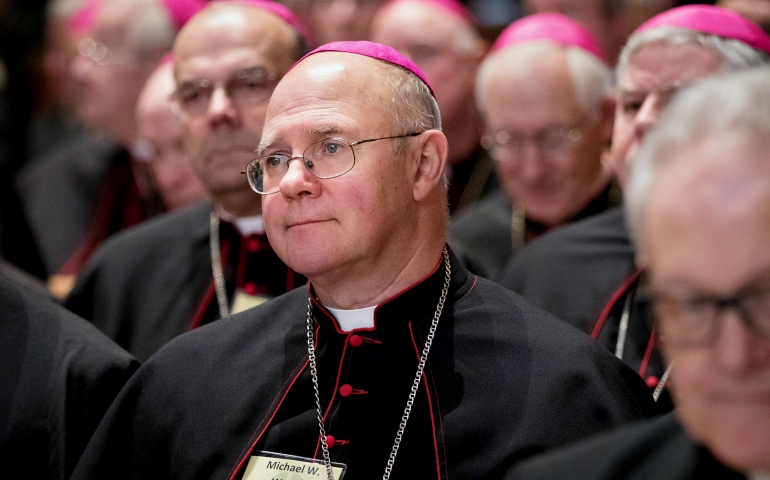
Bishop Michael Warfel of Great Falls-Billings, Mont., listens as Pope Francis addresses U.S. bishops in Washington, D.C., in 2015. (CNS/St. Louis Review/Lisa Johnston)
Are parish assets immune from liquidation?
That was a dominant question among those that pastors and others posed to Great Falls-Billings Bishop Michael Warfel leading up to the Montana diocese's March 31 filing for Chapter 11 bankruptcy protection, brought on by financial pressures from sex abuse lawsuits.
The diocese embraces the concept that parish assets are held "in trust," Warfel told NCR March 31, but attorneys for the currently 72 claimants caution otherwise.
"It is my understanding that the diocese will assert that some of its real estate holdings, investments and cash assets are held 'in trust' for the benefit of parishes, and are thus not available to fund a settlement or jury verdict should any case proceed to trial," Bryan Smith, an attorney whose firm represents nearly half of current plaintiffs, told NCR in an email.*
"However, there does not appear to be any evidence that the parishes are separately incorporated. If the cases do not resolve in mediation, the issue of which assets are reachable in bankruptcy could be the subject of litigation," said Smith, who works for the Tamaki Law firm, which is based in Washington state.
"There has been no court ruling on which diocesan assets are available to fund a potential settlement" and which are "off limits," Smith added. "Whether the court will agree with the diocese or with the abuse survivors on that point is unclear, as it has not yet been raised — and will not be unless the parties are unable to settle the case at mediation."
The diocese filed for Chapter 11 reorganization on Friday afternoon (March 31) in the U.S. Bankruptcy Court for the District of Montana, becoming the 15th Catholic diocese to seek such protection related to sexual abuse by clergy. Two religious communities have also filed for bankruptcy.
Related: New Ulm diocese third in Minnesota to file for bankruptcy, March 3, 2017
A March 31 diocesan media release described the filing as "a major step toward bringing resolution to 72 current claims of abuse of minors by diocesan priests, religious community priests, women religious and lay workers who have served in the diocese."
The legal move was done "to fulfill a pre-bankruptcy mediated negotiated agreement with known abuse survivors and the diocese's liability insurance carrier," it explained.
Diocesan officials and attorneys, representatives of Catholic Mutual Group insurance, attorneys for claimants, and at least a half dozen plaintiffs met for three days of mediation in Seattle in mid-March, according to Darren Eultgen, chancellor of the Great Falls-Billings Diocese.
A key stipulation of the bankruptcy petition, attorneys said, will be outreach via media and other fronts to surface potential other claimants. The court will set the "bar date" or deadline for new plaintiffs to come forth. That time frame is usually three to five months, sources said.
"In this case, we have generally agreed to wait until we know exactly how many claims there will be, then resume mediation to hopefully reach a settlement in a consensual manner," said Ford Elsaesser, who will represent the diocese in negotiations with its creditors.
Any settlement would also include a set-aside fund for potential future claims, according to the diocesan press statement.
"The recent mediation resulted in the beginning stages of general parameters of proposed settlements with the victims and the insurance carrier," the diocesan release stated.
While "details of that comprehensive agreement are still being worked on," it added, the diocese "expects that its reorganization will be expedited by the pre-bankruptcy negotiations."
Press releases from Tamaki Law and from a consortium of five legal firms jointly representing more than half of the 72 claimants both pointed out that the diocese's bankruptcy filing "automatically stays any further action in pending lawsuits against the diocese," in the words of a consortium statement.
The first cases had been scheduled for trial in July. The two comprehensive lawsuits were originally filed against the diocese in 2014.
"However, with the diocese filing bankruptcy instead of fighting each case individually, which would have taken years if not decades, abuse survivors hope that they will receive a measure of justice and accountability within a reasonable period of time," Tamaki Law attorney Vito de la Cruz said in the firm's release.
"The abuse my clients suffered at the hands of diocesan and religious order priests and nuns has caused profound suffering, hardship and despair over their entire lives," he added.
Timothy Kosnoff, a principal of one of the five cooperating firms, called the diocese's announcement a "sensible step forward" and "a bit of a leap of faith."
Mediation can "hopefully work through a lot of issues that can delay and snag" progress, he said. "Bankruptcy represents the only realistic mechanism for working through the myriad of issues involved in a case of this nature."
"Survivors have a need for resolution and closure," Kosnoff said. "The longer it drags on, the harder it is on them. Likewise, it is hard for the church to carry on its mission. Administrative costs are a big concern ... for the diocese and claimants, depleting available resources."
Protracted litigation "is not in the interests of either party," he said.
Still, in a statement issued March 31, Kosnoff warned that a "speedy resolution is unlikely and the future of the diocese remains clouded."
Involved in sex abuse litigation against several church entities over recent years, Kosnoff singled out "overcoming the resistance of the diocese's insurance company ... to honor its legal obligation to pay fair value to settle claims."
"At this time," Elsaesser noted, "the diocese has not identified any other insurance carriers that would have existed before Catholic Mutual."
Nearly all the abuse allegations date from the 1950s through the 1990s.
Elsaesser said, "It seems like everybody in the process is working in good faith and I feel confident that will continue."
Mediation in an open, conciliatory and "pastoral manner," the attorney said, remains central to "reaching an agreement that will fairly compensate the abused survivors and also bring some healing to the process. It is always a challenge. It is still a negotiation."
Elsaesser has worked in similar capacities in other diocesan bankruptcy proceedings, including Spokane in Washington, and Montana's other diocese, Helena.
The Helena Diocese's bankruptcy and reorganization plan was approved almost exactly two years ago in what U.S. Bankruptcy Court Judge Terry Myers called at the time a "singular achievement" and "an enlightened as well as diligent, talented effort to reach an optimum solution for all concerned."
More than 360 claimants were involved in the Helena settlement. Fewer than five hours were actually spent in court, Elsaesser told NCR.
"We would like to beat that record," he said.
Related: Helena diocese reaches sex abuse settlement via 'consensus model,' March 20, 2015
As was Helena Bishop George Thomas, Warfel has been lauded by Elsaesser and some plaintiff attorneys for insisting on respect and compassion for sex abuse victims.
According to chancellor Eultgen, Warfel met with abuse victims as a group and individually during the Seattle mediation period.
Warfel expressed "profound sorrow and sincere apologies to anyone who was abused by a priest, a sister, or a lay church worker" in the diocesan media statement.
None "of those who have been credibly accused remain in active parish ministry," the bishop added. "In fact, nearly all of those accused are deceased."
Based on personal meetings with abuse survivors in the diocese and during the Seattle mediation, Warfel told NCR, "Even if the abuse took place decades ago, there is nonetheless a lingering pain. We have to recognize and acknowledge that. My standard policy is that my door is open to them at any time."
Kosnoff feels the bishop "has made a genuine effort to convey his apologies on behalf of the institutional church" and that "contact with him has been positive."
"He is like many bishops who have inherited these situations," the lawyer said. "Much of this happened decades ago before he arrived on the scene. He is a priest and a bishop, and this is all new to him, too, being embroiled in a complex litigation."
Warfel said he alerted priests in the diocese by conference call the day before the bankruptcy filing.
"Reaction of pastors and the laity has been largely a kind of 'What can we do to help?' " said Eultgen. "There is a feeling of we are in this together from our smallest parishes to our biggest ones."
Great Falls-Billings' 50 parishes and 50 missions cover more than 94,000 square miles of the east two-thirds of Montana, and are home to about 38,000 Catholics, the chancellor said.
[Dan Morris Young is NCR West Coast correspondent and contributes to The Field Hospital feature series.]
*This sentence was edited to clarify who is representing the claimants.



